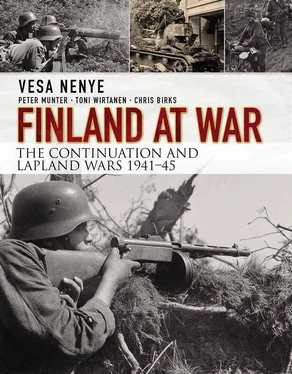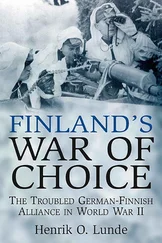5 July
The Lintujärvi–Jänkäjärvi line is reached by the Soviets. Aunus Group continues to fall back, exposing II Army Corps’ right flank and thus also forcing its retreat.
6 July
Four powerful Soviet corps roll forward, capturing Salmi village and crossing the Tulemajoki River in Ladoga Karelia.
7 July
Talvela gives the orders to withdraw to the U Line, the last line of defence in Ladoga Karelia. The last Finnish rearguards do so by 10 July. Due to disobeying orders and retreating, Major-General Blick is relieved from VI Army Corps command and sent to lead the 2nd Division on the Karelian Isthmus. He is replaced by Major-General Martola.
9–17 July
The newly arrived 115th Rifle Corps continues the attack by the 98th Rifle Corps around Vuosalmi. In the end both sides suffer tremendous losses, but the VKT Line still remains under III Army Corps control.
9 July
Soviet forces attempt to cross the Tervajoki River at Viipuri Bay, but are halted by the German 122nd Infantry Division. The Soviet Fifty-Ninth Army moves to the defensive. Finland remobilises older men that have been discharged from service.
11 July
Soviet forces launch a major attack in the Nietjärvi sector. The U Line holds.
13 July
The Soviets take Porajärvi from Colonel Torvald Ekman’s 21st Brigade.
15–17 July
Soviet forces attempt a second breakthrough in the Nietjärvi sector. The U Line still holds.
17–23 July
The battle of Loimola village, involving the newly arrived Soviet 127th Light Rifle Corps on the northern edge of the U Line. Both sides end up entrenched.
17 July
The frequency of Soviet attacks on Finnish positions dwindles. The VKT Line has been shifted, but holds. Both sides adopt trench warfare.
18 July
Aunus Group is disbanded, the front having been stabilised around the U Line ten days previously. Mannerheim again sends Talvela as his envoy to German headquarters. In Ladoga Karelia, VI Army Corps assumes overall responsibility for the defences. The Red Army enters Poland.
25 July–4 August
A Soviet attack forces Major-General Frans U. Fagernäs’ 1st Division to retreat from Suojärvi to Tolvajärvi, digging into defensive positions at the lake narrows.
26 July
Aiming for the town of Ilomantsi, the 289th Rifle Division captures the important Kuolismaa village crossroads, while the vanguard of the 176th Rifle Division on their right flank edges past the former border.
27 July
Alexandra Kollontai tells the Swedish State Secretary for Foreign Affairs Erik Boheman that the Soviet Union is ready to talk peace, on condition that Finland changes its government.
29 July
German forces are recalled from the Karelian Isthmus to protect the front lines threatening Germany.
1 August
President Ryti resigns. Prime Minister Edwin Linkomies acts as president.
2 August
The Soviet 176th and 289th Rifle divisions are encircled in a loose motti by Raappana’s Group R. The Karelian Front sends two naval rifle brigades to relieve their comrades.
4 August
Soviet forces in the Tolvajärvi area cease all attacks, and the front stabilises for the remainder of the war. Mannerheim is sworn in as Finland’s president.
5 August
Major-General Einar Vihma is killed by a Soviet mortar barrage at Ihantala.
9 August
On the Ilomantsi front, Major-General Raappana inflicts heavy losses on the Soviet divisions trapped in the motti . Both sides entrench.
17 August
Field Marshal Keitel, Chief of the German Armed Forces, visits Finland. Mannerheim bluntly informs him that Finland will only keep fighting alongside Germany as long as it is in its own best interest to do so.
25 August
The Finnish ambassador to Sweden, Georg Gripenberg, hands Kollontai a letter containing Finland’s proposal for an armistice.
29 August
The USSR answers Finland’s proposal for peace with its own harsh terms.
2 September
The Finnish parliament accepts a draft peace agreement and terms of armistice with the Soviet Union. Finland breaks relations with Germany and, as demanded, declares that all German troops must leave its territory by 15 September.
3 September
Mannerheim sends what forces he can to the northern front in Lapland. These troops are not yet given orders to fight German troops, but are instructed to garrison the area in the wake of their withdrawal.
4 September
Finnish forces begin the ceasefire as agreed at 08:00. The German Twentieth Mountain Army receives orders to initiate Operation Birke ( Birch ).
5 September
After a further day of attacks, Soviet forces also join the ceasefire.
7 September
President Mannerheim orders the evacuation of civilians from the areas controlled by German forces. A Finnish delegation leaves for Moscow in order to negotiate the final peace agreement. The delegation is led by Prime Minister Antti Hackzell, but after he falls ill, Foreign Minister Carl Enckell takes charge.
11 September
Lieutenant-Colonel Usko Haahti flies to Rovaniemi in order to agree on the terms of the planned ‘Phoney War’ with the Germans.
14 September
Negotiations start for a final peace agreement; the Soviet Union unveils its new, even harsher demands. German forces leave southern Finland. The ‘Autumn Manoeuvres’ or ‘Phoney War’ commences in Lapland.
15 September
The Lapland War begins. The deadline set by the Soviets to drive out the Germans expires. The German Navy attempts a landing against the Finns at Suursaari Island, and suffers a humiliating defeat. The Finns are able to showcase a point of actual warfare, fulfilling the armistice terms.
18 September
Molotov gives Finland one day to consider and sign the peace agreement. Following the German attack at Suursaari, Haahti returns to Rovaniemi to reaffirm the terms for the Phoney War, including the timetable for the German withdrawal.
19 September
The Finnish parliament accepts the terms of peace proposed by the Soviet Union. A temporary peace agreement is signed in Moscow. Puroma’s 6th Division is ordered to push forwards towards Suomussalmi and Puolanka.
22 September
Mannerheim’s daily orders concerning the end of the war against the Soviet Union are made public. Finnish troops led by Colonel Kustaa Inkala meet Soviet forces that have already crossed the border near Suomussalmi.
24 September
Major-General Lagus orders his forces to advance towards Kemi. Shortly after, Mannerheim installs Siilasvuo as overall commander of Finnish forces in Lapland, with headquarters at Oulu.
27 September
Siilasvuo officially takes charge, and moves to put an end to the Phoney War. He issues new orders to his forces.
28 September
The Porkkala Naval Area is ‘leased’ to the Soviets and handed over. The first firefight of the Lapland War takes place between the Finns and the Germans at Pudasjärvi.
30 September
Mannerheim receives threats from the Allied Control Commission that if Finland is unable to evict the German armies on its own, the Soviet Union will send troops to provide immediate support.
Читать дальше












